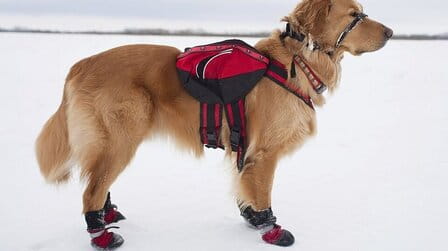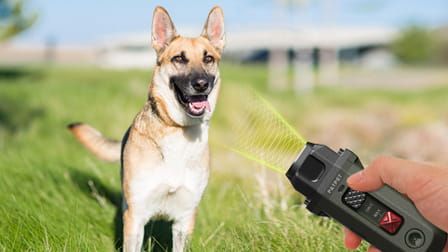Dog bark is a way for owners and pet lovers to recognize the emotions of dogs.
We have clearly listed some different types of dog bark you can understand and easily recognize when your dog barks.
1. Playing dog bark

The play bark is a high-pitched bark that is often repeated in series. If you listen closely, it lacks intensity and is accompanied by a bow where the dog's front legs are lowered and the butt is in the air. Comes with a tail that will often wag in anticipation.
You may notice this when your pet starts a play session. This barking game is used between dogs and humans.
As Feddersen-Petersen observed, some barking games were associated with playful growls and loud voices. Or they may bark because it anticipates play, and exhibit this behavior when watching other dogs play.
What's more, some dogs may just bark for the excitement of playing.
2. Territorial dog bark

This barking is only shown when the thief enters the dog's territory. The barking can be repetitive and increase in intensity as the crook approaches. It can also be mixed with growls. Along with the tail is wagging tail to show anxiety. However, you need to consider carefully how to wag your tail because not all tail wags are friendly.
This territorial call is bold and aggressive, this behavior often rooted in fear. Dogs feel threatened and perceive intruders as a threat to security and comfort.
3 Alarm dog bark

It is a type of alarm consisting of one or two sharp barks that help alert people around the presence of intruders or bad things affecting them and their owners.
The barking sounds sudden and startling.
After hearing the barking, you should note and deal with the related problems. Some dog owners love to say thank you or reward their dog with a gift. Conversely, some dog owners may be concerned that providing snacks will encourage barking.
In essence, you should reward the dog when it stops barking, because when the dog stops barking while you say "thank you" and anticipate the response.
On the other hand, you can ignore this form of barking, which leads to constant barking, as this shows the dog is trying to inform the owner of the situation, but it will make its own ears deaf. Sometimes left unattended, this form of barking can resemble territorial barking because the dog feels the responsibility to check the source of a potential infestation and possibly drive the intruder away.
4. Excitement dog bark

Excitement barking is one of the manifestations of dog barking. Barking occurs when dogs anticipate or experience an exciting or happy event. This pronunciation is high-pitched and repetitive, with short pauses. It will be combined with pacing, jumping, spinning and tail wagging.
Excited barking will be associated with some kind of arousal and, to some extent, represents a lack of impulse control. Some dogs may take the toys and play around with it in their mouth while whining.
5. Fearful dog bark

You may mistake aggressive barking for a fearful dog, but for many trainers, there are several distinguishing features:
You will notice the flattened ears, the lips pulled back, the whites of the eyes showing, the nervous rhythm. This form of barking has a signal gain distance, meaning the dog expects the trigger to move away.
This behavior is often seen in small, less social dogs. Any size of dogs can display this behavior.
Scared barking is high-pitched and repetitive. As affected dogs can run back and forth and if chained, can walk in a zig-zag pattern. At the same time, it is activated by sights, sounds and smells, and can even leave a drop of urine.
Furthermore, a dog responding to a foreign object, like an upside down chair, may be exhibiting approach avoidance. If you want to address the dreaded barking, you need to identify the triggers and implement a desensitization and anti-conditioning program.
6. Boredom dog bark

If a dog can have a happy bark, a dog can also bark a sad bark. A bored, sedentary, and low-stimulation dog will take action to stay busy.
As you know, dogs are social animals, and thrive when in contact with people. Therefore, they need an adequate level of exercise and mental stimulation. A lack of stimulation can also lead to behavioral problems such as barking, digging, and chewing.
A sad barking is a monotonous, repetitive barking that can last for hours. It does not occur as a response to a particular trigger. However, some other dogs that are susceptible to this pattern of barking may engage in destructive behaviors.
On the other hand, these are also self-rewarding behaviors because they trigger the release of psychological decompression hormones. To overcome this is adequate exercise and mental stimulation. Also, incorporate interactive toys, a doggy daycare, or a dog walker into your weekly routine.
7. Demonstration dog bark

This barking is triggered by frustration. Once the dog againsted because their preferred toy disappeared instead of being thrown away. The barking will emit frustration when the dog is prevented from performing a behavior or expectation that does not occur.
This occurs in dogs with activity restrictions such as being tied and sawed by a squirrel, restrained by a leash. Or dogs that are locked in a kennel or want to socialize can also act.
This form of barking is short-lived, helping to remove the dog from the unpleasant situation. Because barking frustration can lead to chewing and digging.
However, good dogs, never chewing on things, frustration can make dogs feel bored and depressed.
8. Attention-Seeking dog bark

Some dogs simply squeal when they want the attention of those around them. If you leave your dog at home alone during the day and you work long hours, that's the attention it causes when you get home. Because they will expect you to play with them, take them for walks, feed them and provide for their basic needs.
Common behaviors are dogs walking towards you with the ball, or sitting next to you to show affection, or petting you. Either form can act as an attention-seeking booster; even when negative attention is a reward for them.
To prevent this type of barking is to not allow this form of address to work anymore. If the dog is engaging in attention-seeking behavior, this is a sign they need plenty of exercise and mental stimulation. Make it a habit to walk your dog and play games with them when you get home.
9. Separation anxiety dog bark

Some dogs are left alone and whine or bark for hours on end, considered a nuisance barker, in fact they suffer from separation anxiety. This phenomenon worries when the owner leaves the house. This causes them to go into a state of panic and seek to be reunited with their owners, whereby whining, screaming and howling, or exhibiting destructive behavior:
- Scratch
- Dig in windows and doors
- Urinate and defecate
- Tempo
- Sweaty feet
- Drooling
Can be helped by a professional behaviorist, or request medication from your veterinarian and a related behavior modification program.
10. Social Facilitation dog bark

It is called the audience effect.
to refer to a dog's tendency to amplify or change behavior based on the behavior of other dogs.
As mentioned above, dogs are social animals, and naturally tend to learn from each other. At times, dogs can be strategically paired with exemplary dogs, from which good behaviors, but in a similar way, reverse bad habits from other dogs.
What's more, your dogs only bark because they hear other dogs barking. To control this behavior by using white noise so that the sounds of other dogs meow less.
11. Canine Cognitive Dysfunction dog bark

It is also known that Canine bark dysfunction, which appears when the dog reaches old age due to the quality of veterinary care available, the dog will become susceptible to cognitive decline. What's more, it's also called Canine Alzheimer's Disease or Canine Dementia, A Cognitive Disorder in Dogs that causes behavioral changes.
The barking pattern is repetitive, monotonous, or these dogs bark because they are confused or need to be taken out.
Notably, a dog with Alzheimer's disease can have cognitive changes that cause dogs to get lost in their surroundings, especially at night. They get stuck in corners or near obstacles, even if it doesn't recognize their owner and comes unresponsive to familiar commands. The way to go is to find medications that your veterinarian can prescribe for this condition.
Conclusion
Recognizing dog barking not only helps you to quickly deal with problems surrounding your dog, but also better understand how to recognize pet psychology so that you can share with them through many daily actions such as: play, feed, go for a walk.
Through the different types of dog bark we provide, hopefully you can find the right direction for your pet.













